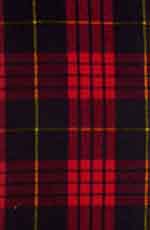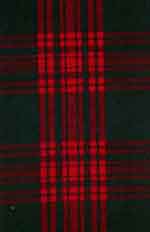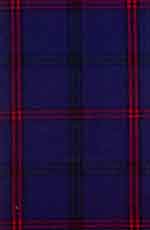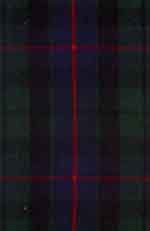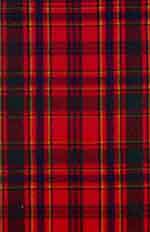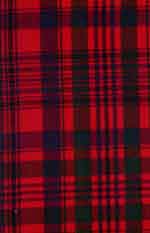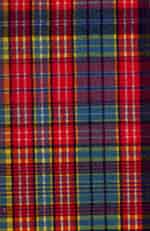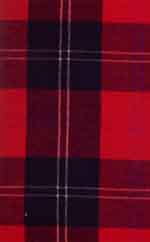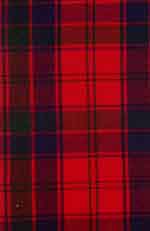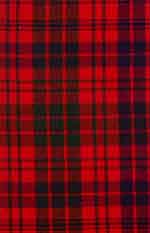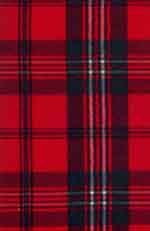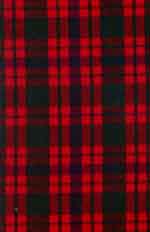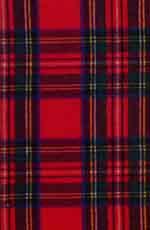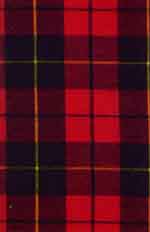|
Scottish Clans and Tartans Part 1: Clans ANDERSON - FRASER of LOVAT Part 2: Clans GORDON - MacDONELL of GLENGARRY Part 3: MacDONELL of KEPPOCH - MacQUARRIE This page: Clans MacQUEEN - WALLACE
The Clan MacQueen is of West Highland or Hebridean origin and originally appear to have been associated with Clan Donald. The name is found in many forms: Cuinn, Suibne, Sweyn, MacCunn, MacSween and MacSwan. In the 13th ct. there were MacSweens in Argyll in the form of Swene and MacQueen for three or four hundred years. MacQueens, MacSwans and MacSweens are numerous in Skye and Lewis, and MacQueens held the lands of Garafad in Skye for several centuries. Early in the 15th ct., when Malcolm, 10th chief of Mackintosh, married Mora MacDonald of Moidart, the bride was accompanied by several of her clansmen, including Revan MacQueen, who settled in the Mackintosh country and subsequently formed septs of the Clan Chattan. He fought under Mackintosh at the Battle of Harlow in 1411. MacQueens settled in Strathdearn on the River Findhorn, and in the 16th ct. were in possession of the lands of Corrybrough. The Clan Chattan Bond of 1609 was signed by Donald MacQueen of Corrybrough for himself and taking full burden of John MacQueen in Little Corrybrough and Sween MacQueen in Raigbeg. The lands of Corrybrough passed out of the possession of the MacQueens in the 18th ct. Robert MacQueen, Lord Braxfield, an eminent if brutal 18th ct. lawyer, was of a Lanarkshire family branch of MacQueens.
The name Macrae (Gaelic: MacRath) means "son of Grace". It is supposed to be of ecclesiastical origin, and the clan appears to have inhabitated the lands of Clunes in the Beauly district in the 12th and 13th ct. and removed to Kintail in the 14th ct. The founder of the Kintail branch is said to have been Fionnla Dubh MacGillechriosd, who died in 1416. Duncan, 5th chief of Kintail, was granted the lands of Inverinate about 1557 which remained in the family for over 200 years. In 1677, Alexander Macrae, eldest son of Reverend John Macrae of Dingwall, received a mortgage (a so-called "wadset") of the lands of Concha and Ardachy and became the progenitor of the Macraes of Concha. The Macraes were loyal followers of the MacKenzies, Lords of Kintail and Earls of Seaforth, whose importance owed not a little to Macraes help. At various dates, Macraes were constables of Eilean Donan Castle, and chamberlains and vicars of Kintail. Reverend Farquhar Macrae, born in the castle in 1580, was a man of influence and importance, and his grandson Donnachadh nam Pios (Duncan of the Silver Cups) was the compiler of Gaelic verses made between 1688 and 1693. The Macraes took a prominent part in the Cicil Wars and were conspicuous for their bravery at Sheriffmiur in 1715, They were not out as a clan in the 1745 Rising but many individuals took part.
The Gaelic Manuscript of 1450 derives the Clan MacMathan or Matheson from the same source as the MacKenzies, and as in 1427 the chief of the Mathesons is reported to have had 2000 men, the Clan Matheson was therefore as powerful as the more famous MacKenzies. The clan was divided into two main branches, those of Lochalsh in Wester Ross and those of Shiness in Sutherland. One notable member of the former was John Dubh Matheson, who was Constable of Eilean Donan Castle when Donald Gorm of Sleat attacked it in 1539 and both leaders were killed by the opposing force. From his son Murchadh Buidhe of Fernaig and Balmacara are descended the families of Bennetsfield, Iomaire and Glas-na-Muclach. The Mathesons of Sutherland were an offshoot from the Lochalsh family and are mentioned in the 15th ct. They are represented by the Mathesons of Shiness, Achany and the Lews. John Matheson of Lochalsh purchased Attadale in 1730. John, 4th chief of Attadale, married Margaret, daughter of Donald Matheson of Shiness, and their son Alexander, born in 1805, was the first baronet of Lochalsh. He made a large fortune in the Far East as one of the founders of Jardine Matheson, an on his return he purchased extensive estates in Ross-shire. James Sutherland Matheson of the Shiness branch purchased the island of Lewis in 1844 and was created a baronet in 1851.
The name Maxwell originates in the Borders and means "Maccus´ wiel or poolin the River Tweed". In the 13th ct. Maxwells were sheriffs of Peebles and chamberlains of Scotland. From Herbert and John, the two sons of Sir Aymer Maxwell, who was Chamberlain in 1241, are descended many prominent Maxwell families. Herbert Maxwell of Caerlaverock in Dumfriesshire, descendant of the first Herbert, was made Lord Maxwell about 1445. John, 3rd Lord, was killed at Flodden in 1513. In 1581, John, 8th Lord, was created Earl of Morton. He was denounced as a rebel but pardoned and eventually killed in a fray with the Johnstons in 1592. In 1608, in revenge for his father´s death, his son, the 9th Lord, killed Sir James Johnston. He escaped arrest and fled Scotland but later returned and was executed in 1613. His brother Robert, 10th Lord, was created Earl of Nithsdale in 1620. The 2nd Earl supported Montrose in 1644 and was succeeded by his cousin John Maxwell in 1667, who was 4th Lord Herries. The 5th Earl joined the Jacobite Rising of 1715 but was captured at Preston and sentenced to death for high treason. Aided by his wife Winifred, who changed clothes with him, he escaped from the Tower of London and died in Rome in 1746. The earldom was forfeited in 1716. His great-grandson, William Constable-Maxwell, proved his claim to the Lordship of Herries in 1858, but in 1908 it devolved upon the Duchess of Norfolk.
This name is of Norman descent and found in various forms - Menzies, Mengues, Mingies and Meyners. It appears in charters in the 12th and 13th ct., and in 1249 Robert de Meyners was Lord High Chamberlain. His son Alexander possessed the lands of Durisdeer in Dumfriesshire, Weem, Aberfeldy and Glendochart in Perthshire, which passed to his son Thomas. At Bannockburn, the Menzies supported Robert the Bruce who granted several chartes of lands to members of the clan. David Menzies was appointed Govenor of Orkney and Shetland in 1423 under the King of Norway. In 1487 Sir Robert de Mengues received a grant of land erected into a barony of Menzies. A century later, in 1587, the "Menyessis of Atholl and Apnadull" appear in the Roll of the Clans. Sir Alexander Menzies of Castle Menzies was created a Baronet of Nova Scotia in 1665 for his contributions to that colony, and the baronetcy continued until the death of Sir Neil, 8th Baronet, in 1910. A distinguished branch of the clan were the Menzies of Pitfoddels. At the Battle of Carbisdale in 1650, the young Menzies of Pitfoddels carried the Royal Standard against the Covenanters. This branch died out, but the last chief, John Menzies, founded the Blairs College seminary. John Menzies of Culdares is said to have introduced the first larches into Scotland from Tyrol in Austria in 1738.
The Montgomerys are a Lowland clan of Anglo-Norman origin. Roger de Montgomery, a Regent of Normandy, followed William the Conqueror to England, where he was created Earl of Arundel. His grandson Robert de Montgomery came to Scotland in the train of Walter, 1st High Stewart of Scotland in the reign of King David I. He received the manor of Eaglesham which was for a long time the principal home of the Montgomerys and witnessed the foundation charter of the monastery of Paisley in 1160. Sir John Montgomery, 9th Earl of Eaglesham, distinguished himself at the Battle of Otterburn in 1388 by capturing Sir Henry Percy called Hotspur. With Percy´s ransom, Montgomery built Polnoon Castle, married Elizabeth de Eglinton and obtained the lands of Eglinton and Ardrossan. Sir Alexander Montgomery was Govenor of of Kintyre and Knapdale in 1430 and was created Lord Montgomery in 1444. Hugh, 5th Earl, died without issue, and the earldom passed to his cousin Sir Alexander Seton, who took the name and arms of Montgomery. During the Plantation of Ulster at the end of the 16th ct., Lady Montgomery of Eglinton set up linen and woollen manufactures in Ireland.
According to tradition, the Clan Morrison is said to be of Norse origin, descended from a family which was shipwrecked on the shores of the Isle of Lewis and saved by clinging to driftwood. In fact, the Morrisons were one of the ancient clans of Lewis, and for a long time the Morrisons of Harbost held the office of "brieve" (=judge) and were known as Clann-na-breitheamh. Hugh Morrison was judge during the latter half of the 16th ct. He was accused by the government of harbouring rebels, and his son John Morrison incurred the displeasure of the MacLeods for betraying Torquil Dubh MacLeod, who was beheaded by the MacKenzies in 1597. The Morrisons in consequence had to to take refuge on the Scottish mainland, and not less than 60 families are said to have fled to Sutherland. On the abolition of the brieveship in the 17th ct., the Morrisons gravitated to the church, and many of them became prominent clergymen. A branch of the clan in the Isle of Harris were celebrated smiths and armourers, and one of this family was the Gaelic poet John Morrison (1790 - 1852).
The home of the Munros has always been Easter Ross. The first recorded person of this clan was Hugh Munro of Foulis, who died in 1126. About a century later George Munro of Foulis got a charter from the Earl of Sutherland. Robert Munro, who had a charter signed by Robert the Bruce, led his clan at the Battle of Bannockburn. Robert, 8th chief, married a niece of Euphame, daughter of the Earl of Ross and wife of King Robert II. William, 12th chief, was knighted by King James IV. He died in 1505. Robert Mor, 15th chief, was a strong supporter of Mary Queen of Scots and received many favours from her son, King James VI. During the 17th ct., the Munros engaged actively in the European wars. For an example Robert, 18th chief, joined the army of King Gustav Adolph of Sweden. He raised 700 men of his own clan for this service and greatly distinguished himself there, where the Scots received the name of "The Invincibles". At that time there were three generals, eight colonels, five lieutenant-colonels, eleven majors and around thirty captains, all bearing the name Munro. Sir Robert Munro commanded the Black Watch at the Battle of Fontenoy in 1745, when, using their own method of fighting (alternatively firing and taking cover) for the first time in a European battle they introduced a system of infantry tactics that was not superseded. On the death of the last Munro of the Foulis line, inheritance passed through his eldest daughter.
This powerful clan had its origin in one of the ancient Pictish tribes of the Province of Moray. The clan name is found in many districts of Scotland, and the principal family is said to be descended from Freskin, wo received lands in Moray from King David I. Freskin´s grandson William was described as "de Moravia". He acquired the lands of Bothwell and others in the south of Scotland, and several of his sons founded other families. He died in 1226. His son, Sir Walter, was the first described as "Bothwell". He was succeeded by his brother, Sir Andrew, a celebrated patriot who organized a rising in Moray and fought with William Wallace to defeat the English at the Battle of Stirling Bridge in 1297, where he was probably killed. His son, another Sir Andrew, was regent of Scotland after the death of Robert the Bruce in 1329. In 1282, Sir William de Moravia acquired through marriage the lands of Tullibardine in Perthshire. One of his successors, Sir William Murray of Tullibardine, who succeeded in 1446, had 17 sons, many of whom founded prominent families of Murray. Sir John, 12th chief of Tullibardine, was created Lord Murray in 1604 and Earl of Tullibardine in 1606. William, 2nd Earl, claimed the earldom of Atholl by right of his wife but died before it was granted. His son, John Murray, obtained the title in 1629 becoming the first Murray Earl of Atholl. His son William, a prominent Jacobite, forfeited the title to his brother.
John, 1st Earl of Atholl of the Murray branch, obtained the title in 1629, and the earldom of Tullibardine was conferred on his uncle, Sir Patrick Murray. Atholl was a staunch royalist. His son John, 2nd Earl, supported Charles I. In 1670 he succeeded to the earldom of Tullibardine, and in 1676 he was created Marquis of Atholl. Disappointed at his reception by King William of Orange, he joined the Jacobites and died in 1703. John, 2nd Marquis, was created Duke of Atholl in 1703 and was a bitter opponent of the Union between England and Scotland in 1707. On his death in 1724, he was succeeded by his third son James Murray. His second son, William Murray, with his brothers Charles and George, were engaged in the Jacobite Risings of 1715, 1719 and 1745. Lord George Murray, who unfurled the stardard of Prince Charles Edward at Glenfinnan, was the brilliant Lieutenant-General of the Prince´s army. As his son and eldest daughter died young, James, 2nd Duke of Atholl was succeeded by his daughter Charlotte Murray, who married her cousin, John Murray, eldest son of Lord George Murray. John Murray succeeded his uncle as 3rd Duke and holder of many other titles of the Murray family. Other branches of the clan were the Murrays of Polmaise, Abercairney, Auchtertyre, Elibank, and many others including the earldoms of Dunmore and Mansfield.
Originally an English name, the Napiers were descended from the ancient Earls of Lennox, and John de Napier, who held lands in the county of Dumbarton, is recorded in a charter of the Earls of Lennox in 1280 and in the Ragman Rolls of 1296. We also know that he assisted in the defence of Stirling Castle in 1303. A descendant of his, William de Napier, was govenor of Edinburgh Castle in 1402. His son, Alexander Napier, who owned the lands of Merchiston, was provost of Edinburgh in 1437, and his son, Sir Alexander Napier of Merchiston, held a number of important posts, including that of Ambassador to England in 1461. Archibald Napier of Merchiston obtained Gartness, Rusky and other lands in 1509. His son, Alexander Napier, was killed at Flodden in 1513, and his son at Pinkie in 1547. John Napier of Merchiston, born in 1550, was the discoverer of logarithms and was considered to be a great mathematician. His son, Sir Archibald Napier, was a Lord of Session and was created Baron Napier of Merchiston in 1627. He was a strong supporter of King Charles I. His son, Archibald, 2nd Lord Napier, fought with Montrose. Archibald, 3rd Lord, died as a bachelor, and the titles passed through the female line to the Scotts of Thirlestane. Francis, 5th Lord Napier, was the grandfather of Admiral Charles Napier, a distinguished British naval commander.
The Ogilvys take their name from Gilbert, a descendant of the ancient Earls of Angus, who was granted the barony of Ogilvy by King William the Lion about 1163. In 1392, Sir Walter Ogilvy of Auchterhouse was killed in a battle with the Clan Robertson. His son, the Sheriff of Angus, was killed in the Battle of Harlow in 1411, and his son, Sir Walter Ogilvy, was Lord High Treasurer and built Airlie Tower. Sir John Ogilvy of Airlie was created Lord Ogilvy, Earl of Airlie in 1491 and was a royalist during the Civil Wars. James, 2nd Earl, was taken prisoner at Philiphaugh in 1645 and sentenced to death, however, he could escape from St. Andrews Castle on the eve of his execution, dressed in his sister´s clothes. The clan actively engaged in the Jacobite Risings of 1715 and 1745. David, 5th Earl, had to flee to France because his father had joined Prince Charles Edward´s army. Receiving a pardon, he returned in 1783 and died in 1813. His son, Walter Ogilvy of Airlie, assumed the title of 7th Earl in 1812, but it was not restored until 1825 when his son David Ogilvy was confirmed in it by Act of Parliament. David Ogilvy, 8th Earl, was killed at the Battle of Diamond Hill in South Africa in 1900.
David de Olifard, who accompanied King David I. on a journey from Winchester in 1141, is said to be the progenitor of the house of Oliphant. In 1458, the title of Lord Oliphant was conferred on Sir Lawrence Oliphant, a descendant of David de Olifard, and the lands of Gask and Aberdalgie were obtained from King Robert I. From his second son, William Oliphant, the Oliphants of Gask were descended, while his thrid son, George Oliphant, founded the Bachilton branch. The Oliphants of Gask were ardent Jacobites, and Lawrence and his eldest son were attainted for their participation in the Rising of 1745. The Scottish poet, Lady Nairne, a born Carolina Oliphant, was of the Gask family and was named Carolina in honour of Prince Charles Edward. On the death of the 11th Lord in 1751, the title became dormant. The Melvilles are a Lothian family, the first settling in Scotland during the reign of David I. He called his manor house "Mala Ville", hence Melville. They soon held many important offices under the Crown. Eventually the family died out, and the Barony of Melville came into the family of Ross of Halkhead through marriage with the Melville heiress. The title Earl of Melville was conjoined with that of the Earl of Leven. The above shown tartan was for a long time known under the trade name of "Oliphant and Melville". A different pattern under the name Melville is found in some early collections of tartan.
The Ramsays are an ancient family of Anglo-Norman origin. The first of this name recorded in Scotland was Simon de Ramsay who was granted lands in Lothian by King David I. He was the ancestor of the Ramsays of Dalhousie. The names of many of the family appear in charters prior to 1296 when that of William de Ramsay appear in the Ragman Rolls. This Ramsay later supported Robert the Bruce, and in 1320 signed the letter to the Pope asserting the independence of Scotland. During the next three centuries the Ramsays were prominently engaged in the Border wars. In 1618, George Ramsay of Dalhousie was created Lord Ramsay of Melrose, a title changed a few months later to Lord Ramsay of Dalhousie. His son, William Ramsay, was created Earl of Dalhousie by King Charles I. in 1633. During the War of the Spanish Succession, William, 5th Earl, was colonel of the Scots Guards sent to support Archduke Charles of Austria. He died in Spain in 1710. George, 9th Earl, a distinguished military man, was created Baron Dalhousie in the peerage of the United Kingdom in 1815. His son, James, 10th Earl, was created Marquess of Dalhousie in 1849. He was Govenor-General of India from 1847 until 1855. When de died in 1860, the title of Marquess Dalhousie bacame extinct. The Scottish title of Earl of Dalhousie and Baron Ramsay devolved on his cousin Fox, 2nd Lord Panmure and 11th Earl of Dalhousie.
The Robertsons, also known as Clann Donnachaidh, are claimed to be descended from the Celtic Earls of Atholl. The clan takes its Gaelic name from Donnachaidh Reamhar, the "Stout Duncan", who was a staunch friend of Robert the Bruce and led the clan at Bannockburn. It was from Robert Riach, the "Grizzled Robert", that the clan took the name Robertson. This Robert was the chief who captured the murderers of King James I. and delivered them to the government. For this service he received, in 1451, a Crown charter erecting his lands into the Barony of Struan. About a century later the Earl of Atholl seized half of the Struan lands under a "wadset" (a mortgage), and the Robertsons never recovered them. The Robertsons were loyal adherents of the Stuarts and accompanied Montrose in all his campaigns, and after the Restoration, Charles II. settled a pension on Robertson of Struan. Alexander Robertson, a celebrated poet and chief of Struan was born about 1670. He was studying for the church when he succeeded to the chiefship, but he left the cloisters and joined Viscount Dundee in 1688. He was attainted but received a remission in 1703. He was out again in 1715 and captured in Sheriffmuir but could escape to France. He was pardoned in 1731 and nevertheless joined Prince Charles Edward in 1745 with the whole clan. He was then too old to fight, however, and returned home in Sir John Cope´s carriage. He died in 1749.
The Clan Rose were settled in the district of Nairn east of Inverness in the 12th ct., and there is documentary evidence to prove that about 1219 Hugh Rose of Geddes was witness of the foundation charter of Beauly Priory. His son Hugh acquired the lands of Kilravock on the Moray Firth by marriage which remains with the family to the present day. In 1433, John Rose, 6th chief of Kilravock, received confirmation of his lands from King James I. His son Hugh built the old tower of Kilravock in 1460. 14 years later the Barony of Kilravock was created. Hugh, 10th chief, was taken prisoner at the Battle of Pinkie in 1547. He was Sheriff of Ross, Constable of Inverness Castle, and Sheriff Principal of Inverness. He died in 1597, aged 90. The Roses were loyal to the government during the Jacobite Risings of 1715 and 1745. Hugh, 15th chief, was Sheriff of Ross and voted against the Union Act of 1707 but was one of the commissioners to represent Scotland in the first British Parliament. Sir Hugh Rose, born in 1803, was in command of the Central Field Force during the Indian Mutiny, in the course of which he fought 16 successful actions, captured 150 pieces of artillery, took 20 forts and captured some important leaders of the enemy. He was raised to the peerage as Baron Strathnairn in 1866 and was made Field Marshal in 1877. Kilravock Castle is still inhabited by the chief of the clan.
The Clan Ross take its name from the ancient Province of Ross and are designated in Gaelic as Clann Andrias. Their progenitor Fearchar Mac-an-t-sagairt of Applecross, the "son of the priest", was a powerful supporter of King Alexander II., and for his services was created Earl of Ross about 1234. His grandson William, 3rd Earl, led his clan at the Battle of Bannockburn, and Hugh, 5th Earl, was killed at the Battle of Halidon Hill in 1333. His successor, William, 6th Earl, died without male issue, and the succession passed through the female line, a circumstance which later led to the struggle for the earldom between the Lord of the Isles and Regent Albany. The chiefship of the clan passed to William´s brother Hugh Ross of Rariches, who obtained a charter of the lands of Balnagowan in 1374. In 1424, the earldom reverted to the Crown, but King James I. restored it to Margaret, mother of Alexander, 3rd Lord of the Isles, and it remained with the Lords of the Isles until the Lordship was forfeited in 1476, when the earldom became vested in the Crown. David Ross, the last of the direct line of Balnagowan, settled the estate on the Hon. Charles Ross, son of Lord Ross of Hawkhead in Renfrewshire. Balnagowan devolved upon George, 13th Lord Ross, in 1745. On the death of the unmarried 14th Lord Ross, Balnagowan went to Sir James Lockhart, 2nd Baronet of Carstairs.
The Scotts, one of the most powerful Border clans, take their name from a race who invaded Scotland at an early date and filtered into many other countries. Uchtredus filius Scoti witnessed chartes between 1107 and 1128, and from him were descended the Scotts of Buccleuch and the Scotts of Balwearie. The Scotts of Buccleuch exchanged Murdochston in Lanarkshire for Branxholm in Roxburghshire. Sir Walter Scott, 13th Baron of Buccleuch, was created Lord Scott of Buccleuch by King James VI. His son raised to the earldom of Buccleuch in 1619. On the failure of the male line, Anna, Countess of Buccleuch, married James, Duke of Monmouth and natural son of King Charles II. who was created Duke of Buccleuch. His grandson became 2nd Duke, and the 3rd Duke succeeded to the dukedom of Queensberry. Sir Michael Scott of Balwearie, knighted by King Alexander II., obtained the lands of Balwearie by marriage with the heiress of Sir Richard Balwearie. Their putative son, Sir Michael Scott, who died about 1300, was an astologer and wizard, who was said to have split the Eildon Hills in three but was actually a most learned man. Of 14 successive barons of Balwearie, 13 were knighted. The family is now represented by the Scotts of Ancrum. Sir Walter Scott, the famous Scottish writer, was a descendant of the Scotts of Harden, one of the many prominent families of the clan.
Clan Shaw was one of the principal clans of the confederation of Clan Chattan. Farquhart Shaw, great-grandson of Angus, 6th Chief of Mackintosh, was, by tradition, the leader of Clan Chattan at the clan battle on the North Inch of Perth in 1396. As a reward for this service he was given the lands of Rothiemurchus, but they were sold in the 16th ct. His son, James Shaw, was killed at Harlow in 1411, and his heir, Alasdair Giar, succeeded him. Alasdair´s brother, Adam (Ay) of Tordarroch, was founder of the Clan Ay. Tordarroch acted for Clan Shaw after 1539, and at Inverness in 1543 and Termit in 1609 signed the the Clan Chattan Bands. The Shaws supported Montrose and raised the Shaw contingent in the Jacobite Rising of 1715. Alasdair´s second son, Alexander Shaw, was ancestor of the Shaws of Dell, his third son, James, was ancestor of the Shaws of Dalnavert, his forth son, Farquhar, was progenitor of Clan Farquharson, and his fifth son, Iver, was ancestor of of the Shaws of Harris and the Isles. The Shaws of the Lowlands have their origins with William de Shaw, whose name appears in the Ragman Rolls of 1296. The Shaws of Sauchie and of Greenock were important branches of the family. After a vacancy of 400 years, ia new chief of Clan Shaw, the 21st, matriculated in 1970. Tordarroch in Strathnairn is still held by the clan.
Of Norman origin, the first of the name was William de Sancto Claro, who received a grant of the barony of Roslin in Midlothian, in the 12th ct. Sir Henry St. Clair of Roslin supported Robert the Bruce, and his son, Sir William, accompanied Sir James Douglas on his journey to the Holy Land with the heart of Robert the Bruce and died fighting the Moors in Spain. In 1379, Henry, son of Sir William, obtained the earldom of Orkney through his father´s marriage with Isabella, Countess of Orkney. William, 3rd Earl, founded Roslin Chapel in 1446, and received the earldom of Caithness in 1455. In 1470, the earldom of Orkney was purchased from the Sinclairs by King James III. The Earls of Caithness were engaged in a long succession of feuds with the Sutherlands, the Gunns, and other clans, and George, 6th Earl, was soon deeply in debt. He granted a disposition of his title and estates to Sir John Campbell of Glenorchy. The Earl died without issue, and Campbell took possession of the estates in 1676. His claim to the title was disputed by George Sinclair of Keiss. In 1680, the Campbells defeated the Sinclairs in battle, but Sinclair´s claim to the title was established in 1681. There are many other prominent Sinclair families including the Sinclairs of Ulbster, but the Sinclairs of Argyll and the west of Scotland, known as "Clann na Cearda" (=craftsmen), do not appear to be connected with the Sinclairs of the north.
The origin of Clan Skene takes us back to the 11th ct., when a younger son of Robertson of Struan saved the life of the king by killing a wolf with his sgian (a Scottish dagger) and was rewarded with the lands of Skene in Aberdeenshire. John de Skene signed the Ragman Rolls in 1296. His grandson, Robert, wqas a faithful follower of Robert the Bruce, from whom he received a charter erecting the lands of Skene into a barony, but the Skenes were very unfortunate in battle. In 1411 Adam de Skene was killed at Harlow, Alexander fell at Flodden in 1513, and his grandson, another Alexander, was killed at Pinkie in 1547. James Skene of Skene supported the royalist cause during the reign of King Charles I. and later served in the army of the Swedish King Gustav Adolph. In 1827 the family of Skene of Skene died out in the direct line, and the estates passed to James, 4th Earl of Fife, who was the nephew of the last Skene of Skene. Other prominent families of Skene included those of Dyce, Halyards, Cariston, Curriehill and Rubislaw. Sir John Skene, a celebrated lawyer, was admitted a Lord of Session in 1594 and took the title Lord Curriehill. William Forbes Skene, the famous writer of the Scotland´s Celtic history, was born in 1809. He was appointed Historiographer Royal for Scotland in 1881 and died in 1892.
The Stewarts are descended from Walter, son of an Anglo-Norman baron, who came to Scotland in the 12th ct. and was appointed High Steward of the royal household by King David I. Walter also received lands in Renfrewshire, Paisley, Pollok, Cathcart, and elsewhere. The office of the High Steward was made hereditary to the family by King Malcolm IV. James, 5th High Steward, bravely supported Sir William Wallace and Robert the Bruce in their struggle for Scottish independence. Walter, 6th High Steward, married Princess Marjory, daughter of Robert the Bruce, and from these were descended the royal house of Stewart. The male line ended with the death of Prince Henry, who was Cardinal Duke of York and brother of Prince Charles Edward, in 1807. Many noble families were descended from the royal line, and the Stewarts have held or still hold the dukedoms of Albany, Rothesay, and Lennox, the marquessate of Bute, and the earldoms of Menteith, Angus, Atholl, Strathearn, Carrick, Buchan, and Galloway. Among other Stewart families were those of Bonkyl, Blackhall, Greenock, Castlemilk, Balquhidder, Achnacone, Invernahyle, Ardsheil, Ardvorlich, Dalguise, Fasnacloich and Grandtully. The Royal Stewart tartan was always regarded as the personal tartan of the royal house of Scotland, and is now the royal tartan of Her Majesty Queen Elizabeth II.
Sir John, Stewart of Bonkyl, was the son of Alexander, High Steward of Scotland, and the ancestor of this West Highland clan. One of his descendants obtained the Lordship of Lorn through marriage to the heiress of Lorn. Sir John Stewart of Lorn was murdered at Dunstaffnage Castle about 1463, and his son Dougal became 1st chief of Appin. He unsuccessfully tried to recover the Lordship of Lorn. The clan fought at the Battles of Flodden and Pinkie. At Pinkie the clan was led by Donald Stewart of Invernahyle, known as "Donald nam Ord". In 1645, they supported Montrose at the Battle of Inverlochy and in the same year also fought at Auldearn and Kilsyth. The chief of Appin was outlawed and his lands forfeited, but they were returned to him after the Restoration. The clan joined Viscount Dundee´s campaign in 1688/89 and supported the Jacobites in both Risings. After the Battle of Culloden, the banner of the Appin regiment was one of the few saved from destruction. In 1765, the estate was sold by the 9th chief, who was succeeded in the chiefship by his cousin Duncan, 6th chief of Ardsheil, who became 10th chief of Appin in 1769. In 1782, he obtained the restoration of his confiscated paternal estate of Lorn.
The territory lying to the south of Caithness was known to the Norsemen as Sudrland, and doubtlessly the inhabitants assumed their name from the district. The Earls of Sutherland, who were chiefs of the clan until 1514, are descended from Freskin, the progenitor of the Murrays. The earldom of Sutherland is claimed to be the oldest in Britain and is alleged to have been granted to William, Lord of Sutherland, in about 1228, who was the great-grandson of Freskin. William, 2nd Earl of Sutherland, fought for Robert the Bruce at Bannockburn, and his son Kenneth, 3rd Earl, was killed at the Battle of Halidon Hill in 1333. William, 4th Earl, married a daughter of Robert the Bruce. His successors had many feuds with neighbouring clans, particularly with the MacKays. John, 9th Earl, died in 1514 without male issue, and the title passed to his sister, whose husband was Adam Gordon of Aboyne. The Gordon Earls of Sutherland encountered the same feuds as their predecessors, and John, 11th Earl, and his Countess were poisoned by Isobel Sinclair at the instignation of the Earl of Caithness. William, 18th Earl, died in 1766. He was the last of the Gordon Sutherlands. Hios daughter Elizabeth, Countess of Sutherland, married George Granville-Leveson-Gower, who afterwards was created Marquis of Stafford and, in 1833, Duke of Sutherland.
The Urquharts derive their name from the district of Urquhart in the old sheriffdom of Cromarty, and are of ancient origin. Sir Thomas Urquhart, who compiled his own genealogy, described himself as the 143th in direct descent from Adam and Eve ... William Urquhart, Sheriff of Cromarty at the beginning of the 14th ct., married a daughter of Hugh, Earl of Ross. His son added considerably to the family possessions. Sir Thomas Urquhart of Cromarty, who married Helen, daughter of Lord Abernethy, is alleged to have been the father of 25 sons, seven of whom were killed at the Battle of Pinkie in 1547. The eldest son, Alexander Urquhart, received a charter from King James V. in 1532, granting him lands in Ross-shire and Inverness-shire. His son, John of Craigfintry and Culbo, was tutor to his grand-nephew, Sir Thomas Urquhart, and was identified as the "Tutour of Cromartie" named in the Roll of Landlords of 1587. Sir Thomas Urquhart of Cromarty was a 17th ct. royalist soldier and writer, chiefly notable for his translation of Rabelais and for his epigrams. Colonel James Urquhart, who died in 1741, was the last of the male line. The chiefship passed to the Urquharts of Meldrum who are descended from John, the Tutor of Cromarty. The chiefship became dormant in 1898 and remained so until 1958 when the present chief was adjuged heir male and chief by Lyon Court.
In old Latin documents the term "Wallensis" or "Walensis" was used to designate the Welsh, but in Scotland it was used more particularly to describe the Britons of Strathclyde who were of the same stock. From this word the name Wallace is derived. In the 12th ct. Richard Wallace obtained extensive lands in Ayrshire in the district now known as Riccarton. His descendant, Sir Malcolm Wallace of Elderslie, was the father of Scotland´s greatest patriot, Sir William Wallace, who was his second son. Although very young, William Wallace became the leader of a company of patriots, and his harassing tactics against the English earned him the support of many nobles. His reprisal against the English garrison at Lanark for the murder of his wife and the burning of the "barns of Ayr" in revenge for the murder of his uncle and other Scottish gentlemen who had been invited to a conference, gained him still more supporters. His military genius made him hated and feared by the English Kind Edward I., and his only defeats were brought about by the jealousy and treachery of the nobles in his own army. By treachery, he was captured at Robroyston, near Glasgow, and delivered to Edward I. by Sir John Menteith. He was brutally executed in London in 1305. The Wallaces of Craigie, Cessnock, Kelly and Cainhall were all descended from the original family of Riccarton in Ayrshire. |
Part 1: Clans ANDERSON - FRASER of LOVAT
Copyright © 2022 by Mag. Peter Csar - All rights reserved.
